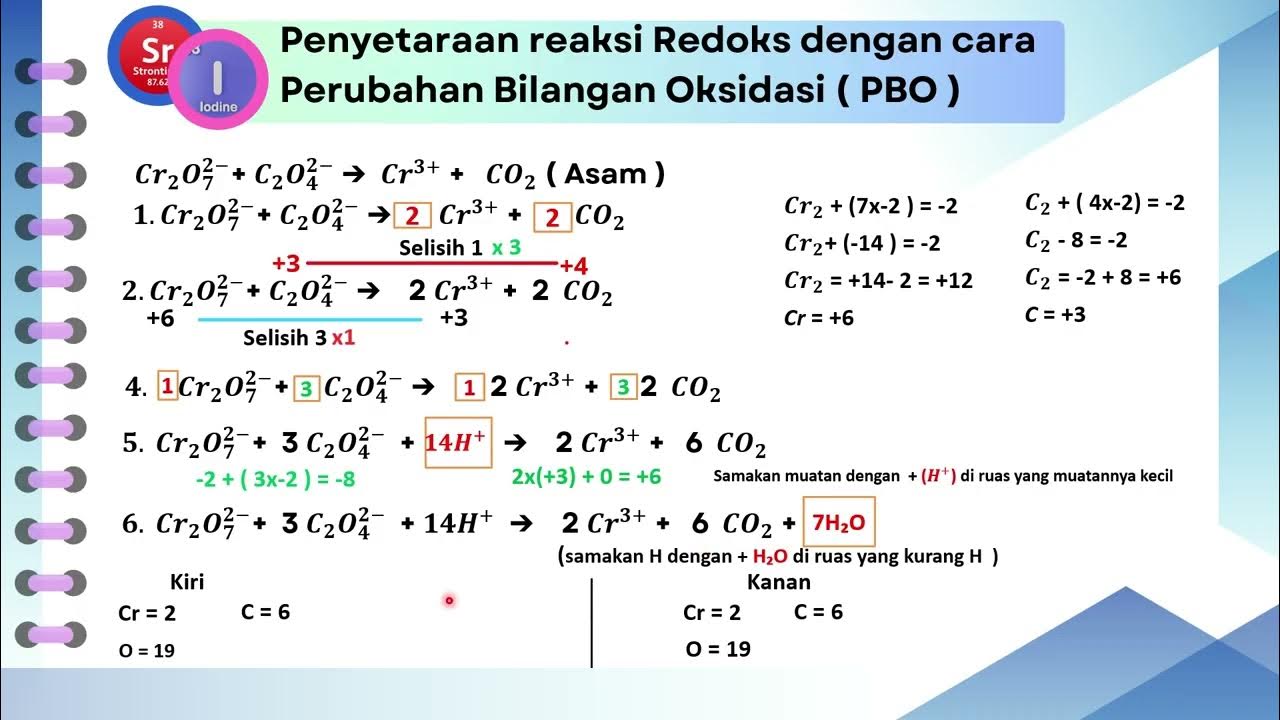Penyetaraan Reaksi Redoks Metode Bilangan Oksidasi | Kimia SMA | Tetty Afianti
Summary
TLDRIn this chemistry lesson, the teacher explains the method of balancing redox reactions using changes in oxidation numbers, specifically for 12th-grade students. The lesson begins with a simple overview of redox reactions and the importance of balancing both atoms and charges on both sides of the equation. The teacher then outlines a step-by-step process, including calculating oxidation states, balancing atoms and charges, and adjusting for acidic or basic conditions. Several examples are worked through to illustrate these concepts, followed by practice problems for further learning.
Takeaways
- 📚 The lesson covers how to balance redox reactions using the oxidation number method for 12th-grade chemistry.
- 🔢 The first step in balancing redox reactions is identifying atoms that change their oxidation numbers.
- ⚖️ It's essential to ensure that the total number of atoms and charges on both sides of the equation are balanced.
- 🧪 The oxidation number method involves five key steps, including balancing atoms, calculating oxidation number changes, and adjusting charges using H+ (in acidic conditions) or OH- (in basic conditions).
- 💡 In a redox reaction, an increase in oxidation number indicates oxidation, while a decrease indicates reduction.
- ➗ Coefficients must be adjusted to balance the atoms undergoing oxidation and reduction, ensuring the reaction is fully balanced.
- 💧 In acidic conditions, H+ ions are added to balance the charges; in basic conditions, OH- ions and water molecules are used.
- 🔍 Examples of balancing complex redox reactions, like Fe2+ with MnO4-, are demonstrated, including the use of oxidation numbers and coefficients.
- ⚗️ The lesson emphasizes the importance of ensuring that both the total charge and the total number of atoms are equal on both sides of the equation.
- 📝 Practice problems are provided for further learning, with a focus on redox reactions in both acidic and basic environments.
Q & A
What is the primary topic covered in this chemistry lesson?
-The primary topic is the method of balancing redox reactions using the oxidation number method.
Why can't the trial-and-error method be used for complex redox reactions?
-The trial-and-error method is not suitable for complex redox reactions because it does not account for the need to balance both the number of atoms and the charges on both sides of the reaction.
What is the first step in balancing a redox reaction using the oxidation number method?
-The first step is to identify the atoms that undergo a change in oxidation number.
How do you balance the charges in a redox reaction under acidic conditions?
-Under acidic conditions, you balance the charges by adding H+ ions to the side with fewer positive charges.
What additional step is necessary when balancing redox reactions under basic conditions?
-In basic conditions, you add OH- ions to balance the charges after balancing the oxidation numbers.
In the example given, how is the oxidation number of Mn in MnO4- calculated?
-The oxidation number of Mn in MnO4- is calculated by assuming oxygen has an oxidation number of -2, and solving for Mn to balance the overall charge of -1.
Why is it important to multiply the coefficients of the species involved in oxidation and reduction by factors of their respective changes in oxidation numbers?
-This is done to ensure that the number of electrons lost in oxidation equals the number of electrons gained in reduction, thereby balancing the overall reaction.
How is the overall charge balanced in the redox reaction involving Fe2+ and MnO4-?
-The overall charge is balanced by adding 8 H+ ions to the left side, resulting in equal charges on both sides of the equation.
What is the significance of adding H2O to the balanced redox equation?
-Adding H2O helps to balance the hydrogen atoms in the reaction after the addition of H+ ions, ensuring both mass and charge balance.
What final advice does the instructor give for solving redox reactions under acidic and basic conditions?
-The instructor advises to carefully balance the oxidation numbers, charges, and atoms in both acidic and basic environments, and to practice with additional problems for better understanding.
Outlines

This section is available to paid users only. Please upgrade to access this part.
Upgrade NowMindmap

This section is available to paid users only. Please upgrade to access this part.
Upgrade NowKeywords

This section is available to paid users only. Please upgrade to access this part.
Upgrade NowHighlights

This section is available to paid users only. Please upgrade to access this part.
Upgrade NowTranscripts

This section is available to paid users only. Please upgrade to access this part.
Upgrade NowBrowse More Related Video

Persamaan reaksi redoks

PENYETARAAN REAKSI REDOKS REAKSI REDOKS CARA BILANGAN OKSIDASI

[MASTER KIMIA SPM] KIMIA KSSM TING 5 : KESEIMBANGAN REDOKS

BALANCEAMENTO POR OXIRREDUÇÃO - PASSO A PASSO

REAKSI REDOKS DAN ELEKTROKIMIA - MATERI KIMIA KELAS 12 | Edcent.id

Module 2 - Balancing Redox - Oxidation Number Method - 1
5.0 / 5 (0 votes)